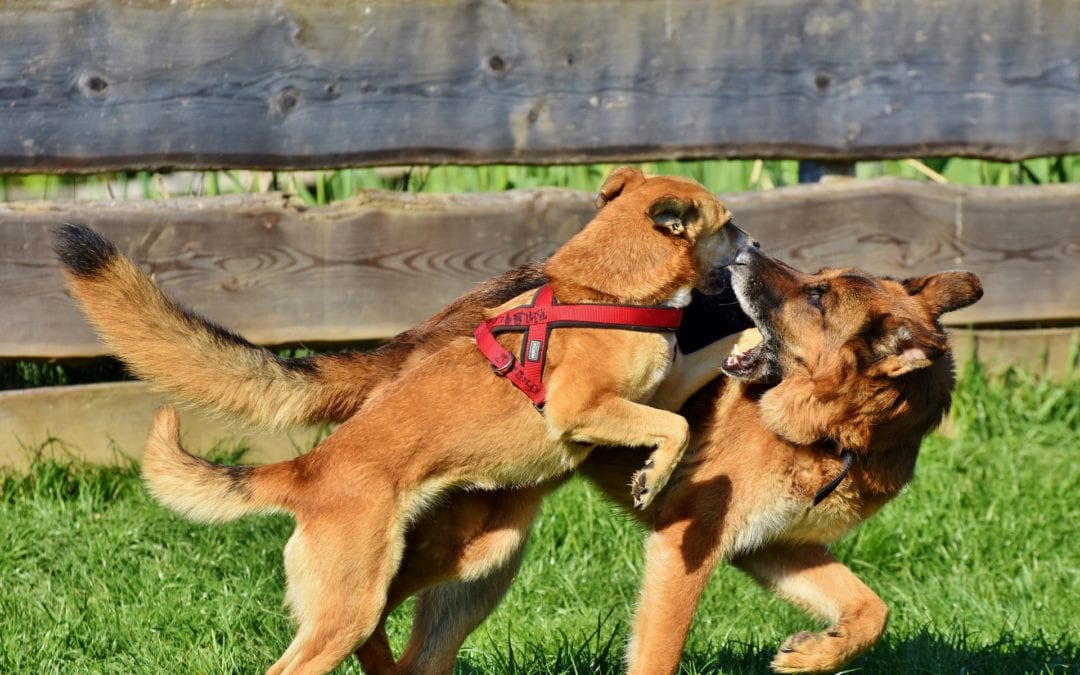First, let’s real simply talk about how dogs think. Picture a pack of wild dogs or wolves. To hunt successfully, they must all be very clear about their place within the hierarchy of the pack. There are very clear rules for hunting, eating, and feeding the young and old. This is wired in their DNA, their hardware. So the way I think about your dogs is that they also find it very important to know where they fit in the hierarchy of your pack. Once you figure out what your pack hierarchy is, you can take steps to get your dogs comfortable again. But how do you do this? Dogs who fight are typically very closely matched, and they may not be vying for the top dog spot. Maybe in your home, that spot is taken by an extremely confident dog who no one is going to challenge. Sometimes #2 and #3 are trying to figure things out. It’s not always easy to figure out the pecking order, but here are a few tricks:
- When they have fought in the past, who finally backs down and tries to stop the fight? That’s the dog who is more submissive.
- If a cookie or bone drops on the floor, who will win it? That’s your more dominant dog.
- When walking both on a leash, who makes sure they are in front, if even by a few inches? When opening the door to let them outside, who makes sure they edge out of the door first? That’s the more dominant dog.
- When you return home, who edges the others out of the way to make sure they get attention from you first? That’s your dog who is more in charge.
- Think about their breed(s) as well. In their DNA do they have a breed that is a “take charge” type? Think all “bully” dogs, terriers, Rotties…. They naturally are going to want to be in charge.
- Who’s naturally the bigger, stronger, faster, younger, and more vital dog? This dog knows it. Maybe the younger dog now knows he/she is stronger than the older, previous top dog.
You may notice, sometimes the dogs flip-flop roles. When it comes to food, one dog will always win. But in all other circumstances, the other one would win out. This is the hard part, and likely one of the reasons the fighting started – the dogs are closely matched. You may think the dog who seems to start the fight is the more dominant dog, but this is not always true. Sometimes the underdog is being treated like the top dog by the humans and wants the other dogs to follow suit. So how do you stop the fighting? Dogs in the wild will totally work out the hierarchy amongst themselves. Or they will leave and find a new pack that fits them better. It is only the humans who confuse the pecking order and create confusion within the pack. Identify what order your dogs are NATURALLY in, and support that natural hierarchy. How do you do this?
- Feed them in order of their hierarchy. 1, 2, 3, 4…. You can prepare all food at the same time, you just set it down for them in that order. If they can not safely eat together, still feed them in that order, and make sure they all see you feeding this way.
- Treats and toys must also be given in that order as well. If they still fight over these high-value items, consider eliminating them from the home. In my house, if my human or furry kids can’t behave around a certain toy, the toy has to go.
- Give the first attention and best resting spots them in that order as well.
So what happens when you don’t do these things? All of the dogs are confused and uncomfortable. This is why you will see them come into a room and give each other a “dirty” look “for no reason”. Or they snap at each other seemingly unprovoked. Eventually, this leads to all-out brawls. The simplest way I use to think about it is that the more dominant dog sees the other dog(s) being escalated by their humans and feels the need to constantly put the other dog(s) in their place so that the proper order is reestablished. As mentioned before, sometimes the underdog thinks they need to make a play for a higher rank since the humans keep sending messages that they are “top dog”. Here are the most common reasons I see the hierarchy becomes confused in the home:
- The smaller dog is allowed on the bed and/or couch and the larger (stronger) dog is not.
- The more dominant dog has to be crated because they are not fully potty or house trained and the less dominant dog is allowed to roam free (thereby having the best resting spots).
- The older or more established dog gets first priority treatment because they were there first, even though the younger and newer dog is naturally stronger mentally and physically and should be treated as alpha.
- The less dominant, “sweeter” dog is rewarded for their sweetness by being given first priority for resources. (Sorry, but you are setting this dog up to get picked on.)
- The dog showing dominance is punished by being placed in a crate or on the floor and has to watch the other dog be elevated to a better resting spot.
Remember, ultimately, the humans should be in charge, the “ultimate alphas” within the home, so it’s appropriate to tell your dogs when they are not behaving how you expect them to. Also, the dogs who are likely to fight with other dogs seem to be more insecure than those who don’t fight. That is why it is very important for you to expect manners and confident behavior from all of your dogs. One great way to do this is to expect them to SIT-STAY for everything they want – food, treats, attention walks, going outdoors. Once all are sitting, each dog should be rewarded IN THE ORDER of their hierarchy. 1-2-3… That simple. If your household dictates the stronger dog must be crated, then do it in a private room where they don’t see the other dogs free, maybe even in the favorite room like a bedroom. Let that dog out of the crate first and greet them before the other dogs. It’s hard, right? Especially when you are frustrated with one of the dogs for “picking fights”.
Here’s the good news. This method works. The hardest part is identifying what the pecking order is. Once you support the hierarchy, it becomes second nature. The other piece of good news? I don’t think your dogs really care where they fit, just that they all do fit. I don’t think their feelings are hurt by being #2 or #3. They are happier and more stable just knowing what the order is. It doesn’t mean you love them more or less. Humans think like that, dogs don’t. They love it when you have provided a stable and safe home for them. Good luck and be careful! (And call us if you need us.)
Dr. Nicole Sheehan

